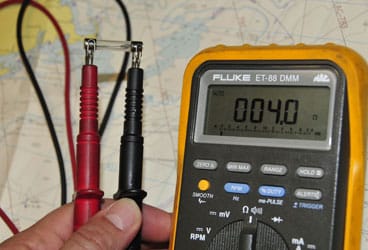
Multimeter Resistance
In the fourth and final installment of this series on understanding and using multimeters, we’ll examine the resistance function and how it can be used for various troubleshooting and repair procedures.
The ability to measure resistance is among a multimeter’s most basic, and valuable, functions. With electricity, resistance is the ultimate arbiter of the efficiency with which any electrical system, appliance, or component operates. In most cases, a certain amount of resistance is to be expected; all wiring, incandescent lights, and batteries impart resistance to an electrical circuit. With regard to wiring and connections, less is best.
How does this affect the way gear operates? With wiring runs, the wire’s length and gauge (or diameter) present some of the most commonly encountered resistance issues faced by cruisers. With longer runs, the electricity flowing through those wires will encounter greater resistance. With navigation lights and wiring to the masthead, for instance, resistance invariably diminishes the voltage that reaches the light. (Voltage is also lost in the form of heat radiating from the wire, though this is usually an amount almost too tiny to measure.) In extreme cases, however, high resistance can and often does lead to overheated wiring, and even to fires.
In addition to length, wire size has a dramatic effect on resistance, with larger-diameter cables presenting less resistance to the flow of electrical current. For instance, if the cable between the alternator and the battery or the one between the battery and starter is undersized, it will impart significant resistance, thus generating heat and causing these components to lose efficiency.
On a regular basis, use your multimeter’s resistance function—marked by Ω, the Greek letter omega, which is the symbol for ohms, the unit of measure for resistance—for a variety of troubleshooting tasks. You can, for instance, determine the resistance in circuits that aren’t performing properly. You can also check an ignition switch to determine if its contacts are connecting when the switch is turned on and completely breaking contact when it’s turned off; a switch that’s wet, for example, can often retain some degree of connection, which can lead to a dead battery or an engine that starts itself. If the engine refuses to start and there’s sufficient voltage at the starter’s positive or secondary post but no voltage at the primary connections for the solenoid, the switch is often the culprit, and using a multimeter set to the resistance function can confirm this. The resistance function can also be used to verify the condition of a fuse, determine if it’s blown, and identify oxidation on the contacts, which could lead to overheating.
Troubleshooting or confirming the operation of a bonding and zinc-anode system is yet another area where resistance measurements are extremely valuable. The resistance between an anode and a propeller or shaft should be no more than 1 ohm, and the same holds true for resistance measurements throughout a vessel’s bonding system. Use the multimeter to test those crusty, green bonding connections at your seacocks or keel bolts: Chances are good that you’ll encounter significantly more resistance, the consequences of which will be zinc anodes that aren’t able to do their job properly and, potentially, increased galvanic-corrosion activity.
Steve D’Antonio offers services for boat owners and buyers through Steve D’Antonio Marine Consulting.








